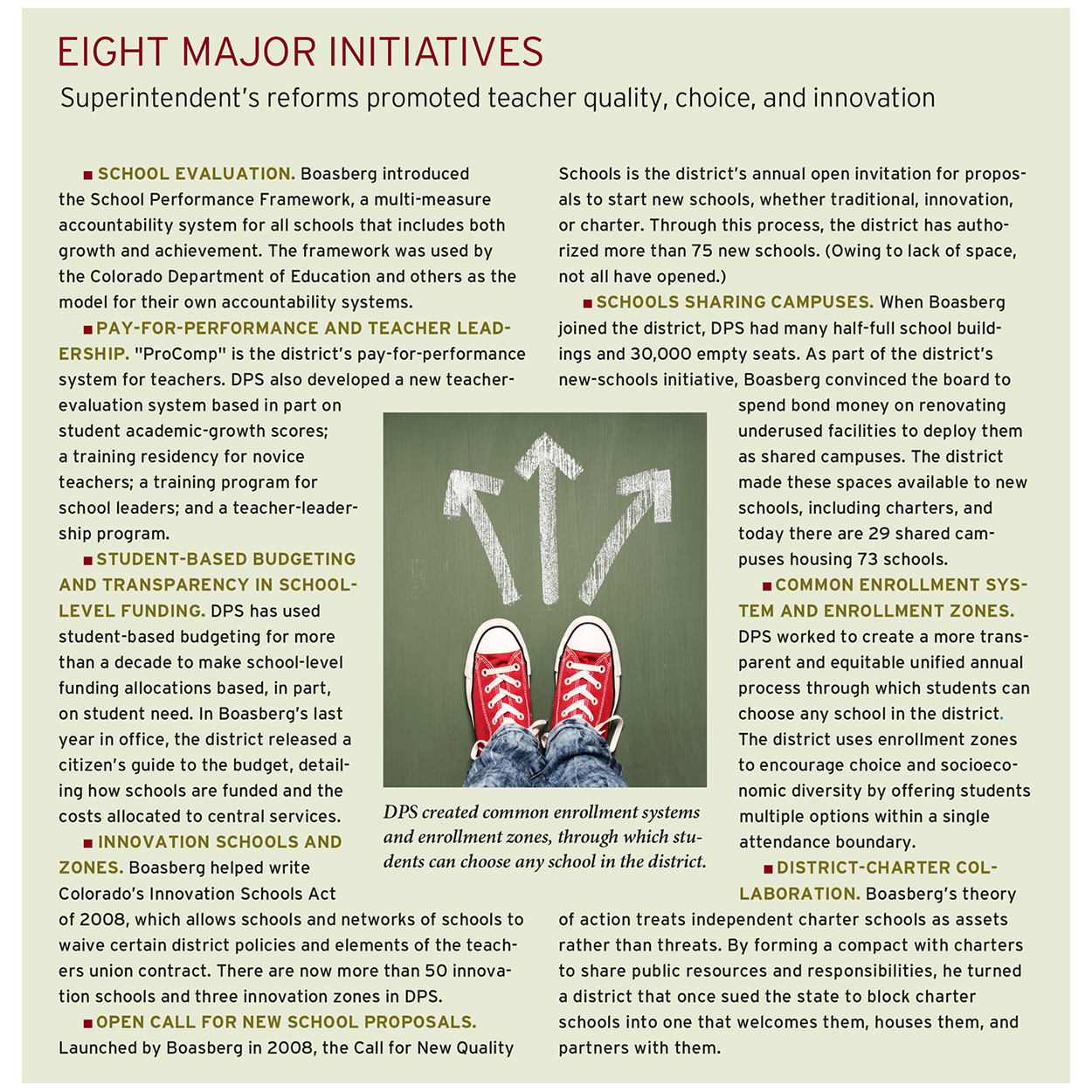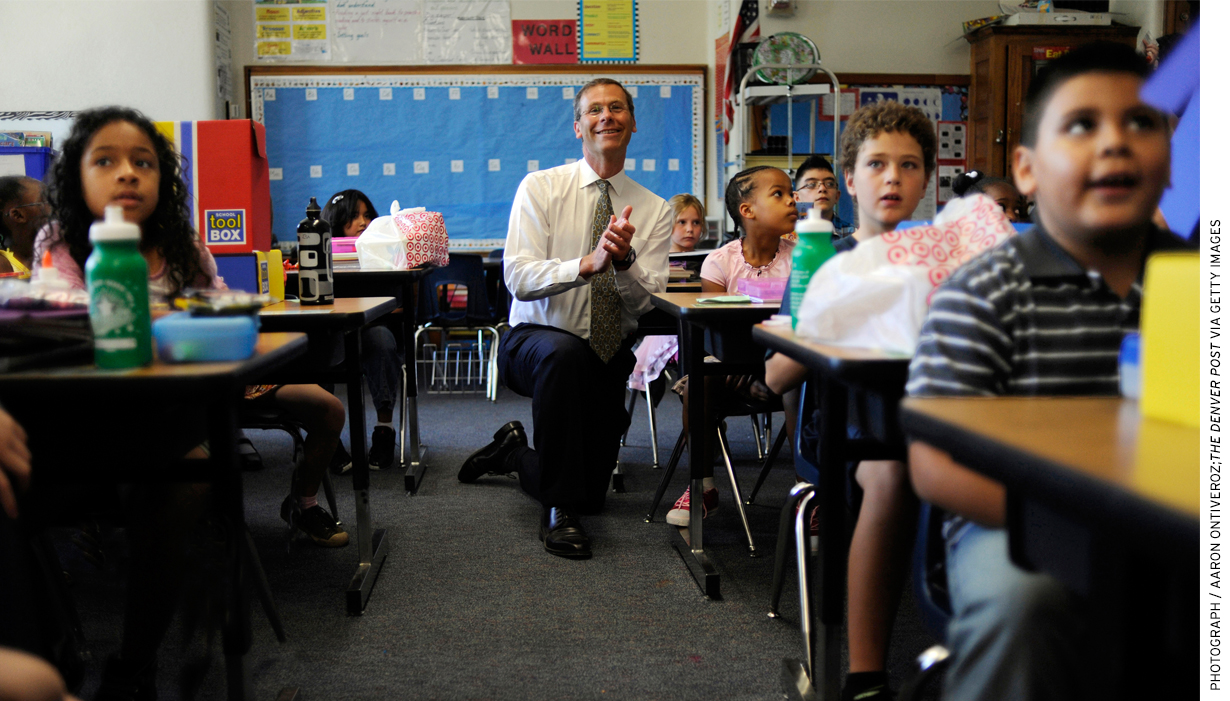
In October 2018, when Tom Boasberg stepped down as superintendent of Denver Public Schools (DPS) after 10 years on the job, he was no doubt frustrated to see his longtime critics rejoice. What likely disappointed him most, though, was that some of his strongest supporters abandoned him, too.
Boasberg’s opponents were happy to see him go because they think he “destroyed public education” in Denver by transforming the 92,000-student district in ways they disdain. Some of his once-strongest supporters lost confidence in his leadership because they don’t think he transformed it enough. And everyone seems to blame him for not closing the city’s wide and persistent achievement gap between middle-income, largely white students and lower-income and minority students.
Boasberg began his tenure by declaring Colorado’s largest district and its centralized, top-down model for providing public education fundamentally broken. In the years that followed, the superintendent and school board implemented a wide array of unconventional reforms aimed at transforming DPS from a closed school system into a dynamic system of schools.
When Boasberg first took the reins, it would have seemed wildly improbable that Denver would nearly erase its 25-point lag behind the state in average reading and language-arts proficiency, or that the Latino graduation rate would increase by 17 points, or that more than 65 new schools would open. But that’s exactly what happened.
In light of these changes, how did Boasberg acquire so many adversaries? The answer is not simple, but a more seminal question is, how did he manage to gather enough support to effect these radical changes in the first place? Boasberg was a centrist, and he built a coalition based on pragmatism and a shared belief that change was a long overdue moral imperative. At the height of the national bipartisan consensus on education reform, he was its standard bearer, and, for longer than anyone before him, he made his strategy work. His lengthy tenure and the changes he implemented demonstrate that traditional school districts and their elected boards are capable of reinventing themselves. His work in Denver is a rebuke to those who insist that traditional districts are the “one best way” to provide public education—but it is also a reminder of how difficult it is to build an alternative model.
A Different Kind of District
Boasberg first joined DPS in April 2007 as its chief operating officer (COO), hired by then superintendent Michael Bennet, a childhood friend. (Note: Parker Baxter, one of authors of this piece, worked for DPS under both Bennet and Boasberg, from 2008–11.)
The following month, the Rocky Mountain News painted a dire picture of the district: “A quarter of the city’s school-age children don’t attend Denver Public Schools. Among Anglo students, a quarter go to private schools. In some southwest Denver neighborhoods, half the kids go to suburban districts. Enrollment at independent charters has skyrocketed 300 percent in six years.”
District leaders were not angered by the report. In fact, they had partnered with the reporters to collect and analyze the data. Bennet and the school board publicly accepted responsibility for the state of the district and issued a call for radical change. Based in part on the report, they concluded that “operating an urban school district in the 21st century based on a century-old configuration will result in failure for too many children.”
They proceeded to outline a vision for a different kind of district, one that embraced choice and competition and empowered educators and schools by holding them accountable for results. Bennet and the board argued that the district needed to “function more like a partner [with educators], building capacity and leadership at the school level and serving as an incubator for innovation.”
Although Boasberg was not yet superintendent when the district published its “Vision for a 21st Century School District,” that vision set the course of his tenure.
An Education Outsider
Boasberg was named superintendent in January 2009, after Bennet was tapped to fill a U.S. Senate seat. Boasberg had played a key role in developing Bennet’s reform plan, and the school board decided to skip a national search.
Aside from Boasberg’s two years as COO of DPS, his only prior education experience was a brief stint as an English teacher in Hong Kong. An attorney by training, and skilled in operations and finance, he had worked on telecommunications policy at the Federal Communications Commission and then as an executive in the private sector. At the time, Boasberg’s supporters touted his outsider status as evidence that he would accelerate Bennet’s reforms.
Boasberg started by updating the strategic plan launched five years earlier. At the time, the Council of the Great City Schools called the Denver Plan “one of the most promising and comprehensive in the nation.”
Given his private-sector background, it is tempting to view Boasberg as just another “businessman” coming in to fix a broken school system. Although he based his reforms partly on private-sector concepts, he demonstrated a deep dedication to improving public education in Denver over his decade of service. And unlike some outsiders who try to impose business or military discipline on chaotic systems, he took office with an articulated theory of change and a mandate to implement it. Moreover, Boasberg was aiming for transformation, not simply tweaking around the edges. He intended to redesign Denver’s traditional city school system from the ground up.
In outlining his vision, Boasberg called on the district to “acknowledge that our culture historically has not been one consistently defined by high expectations, service, empowerment, and responsibility,” arguing that DPS, like districts nationwide, “has operated for generations as a monopoly and has suffered from a monopoly’s resistance to fundamental change, a lack of urgency and inflexibility that often puts the interests of the system and its adults over and above the needs of our students.”
The district would continue to fail its students, he asserted, especially its most vulnerable, unless it was willing to recommit to its fundamental purpose—educating students—by reimagining its function and redesigning its structure to meet contemporary demands. Boasberg proposed new organizing principles for the district: accountability, empowerment, choice, transparency, and equity.
Over the following decade, these concepts informed the controversial reforms he implemented, including new approaches to school and teacher evaluation, merit pay, and openness to charter and innovation schools (see sidebar). These reforms were not random. Each was part of a deliberate strategy launched by Bennet and implemented by Boasberg to redesign the city’s school district.
Transforming a School District
The original Denver Plan, introduced by Bennet in 2005, was the first vision statement in the district’s more than 100-year history. Although bold for its time, it was conventional compared to the revisions Boasberg led four years later. In 2010, Boasberg and the board made explicit their intention not only to continue Bennet’s controversial reforms but to accelerate them by coupling new organizing principles with a “theory of action” to guide the district’s work. Boasberg and the board framed the plan as an effort to “fundamentally chang[e] the culture and structure of public education” in Denver. They praised the progress made under Bennet but were brutal in condemning the district’s continued failings. If it hoped to make real progress for all students, they argued, the district didn’t need just a new way of thinking, but also a new way of acting.
Teacher quality. A core idea in Boasberg’s theory of action was that traditional districts disempower their most important assets—teachers and school leaders—by treating them like cogs in a compliance machine. Thus, Boasberg led a variety of policies aimed at setting clear performance expectations and using accountability to improve teacher and principal quality.
When Boasberg took office, DPS had already implemented a teacher pay-for-performance system called ProComp (Professional Compensation Plan). Developed in tandem with the teachers union, ProComp had been piloted, supported financially by voters, and was due for renewal when Boasberg became superintendent. At the time, it was one of the nation’s first and most comprehensive efforts to evaluate teacher quality and reward strong performance with higher pay.
Although ProComp did not revolutionize the district’s relationship with teachers, studies show it improved teacher satisfaction and retention. It also demonstrated the viability of compensating teachers using an alternative to the traditional step-and-ladder system.
Implementation of ProComp was rocky under Boasberg and was made more complex when the district, in response to a state mandate, designed a new and largely separate teacher-evaluation system, Leading Effective Academic Practice (LEAP), which triangulated teacher evaluations based on classroom observations, student academic-growth scores, and student evaluations. LEAP increased flexibility in how teachers were deployed and freed up time for strong teachers to support their peers’ development; it also expanded teacher-leadership opportunities.
LEAP and ProComp were operated in parallel when, in hindsight, they might have been more effective if merged into one system. Later studies show that teachers struggled to understand how they could earn more base pay and bonuses under these two systems. And despite evidence that the pay incentives available to teachers under ProComp had a significant impact on year-to-year retention, particularly in hard-to-staff positions and schools, Boasberg was never able to convince the union of the merits of the system.
Boasberg also focused on other less visible but significant aspects of the district’s approach to human capital—for example, through his decade-long fight for mutual-consent hiring between school leaders and teachers. For years, DPS had frequently engaged in “direct placement”—the practice of assigning a teacher to a new post, even over the objections of the teacher and principal. Even before he became superintendent, Boasberg zeroed in on the practice as inconsistent with a culture of empowerment and accountability. In 2010, he partnered with Colorado legislators to prohibit districts from placing teachers into schools without the mutual consent of the teacher and the principal. Since then, DPS led the state’s districts in ending forced placement, and it did so while successfully fighting a lawsuit by the teachers union to maintain the practice.
Choice and competition. Boasberg’s theory of action embraced competition from other school providers, cultivating entrepreneurial educators and encouraging choice for families. As COO in 2007, he led the creation of the Office of New Schools, which ultimately became the Portfolio Management Team, a reference to the portfolio district strategy pioneered by Paul T. Hill and colleagues at the Center on Reinventing Public Education (CRPE). Modeled on offices created under superintendents Joel Klein in New York and Arne Duncan in Chicago, the idea was to create a district team responsible for evaluating new-school proposals and overseeing new schools.
In 2008 DPS launched its first Call for New Quality Schools, a public invitation for school start-up proposals, whether charter or district-operated. Based on best practices for authorizing charter schools, the process developed by Boasberg evaluated applications on the strength of the proposal and the operator’s record of success, without regard to governance type. Charter and innovation schools have increased in number relative to traditional public schools (see Figure 1).
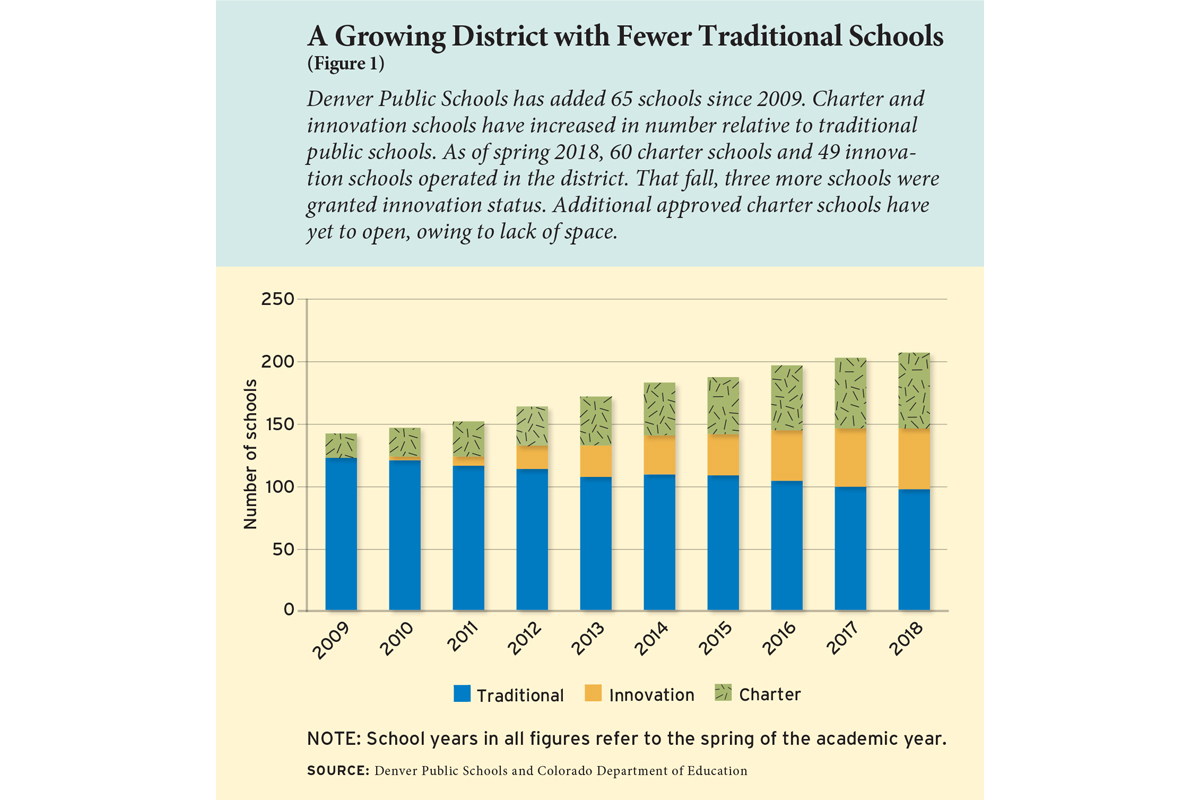
Since launching the annual call for new schools, the district has approved the opening of more than 75 new charter and district schools. Not all have succeeded, and some have yet to open, owing to lack of space, but many are now among the district’s best performers while serving the highest-need students. The Call for New Quality Schools fostered the growth of local charter-management organizations, such as DSST Public Schools, STRIVE Prep, Rocky Mountain Prep, and University Prep. Each started with a single school.
Accountability. In the 2010 Denver Plan, Boasberg noted that “traditionally, public school systems have promoted neither empowerment of education professionals nor accountability for students’ success.” Instead, he said, “we have created systems that value and enforce compliance over performance.” His theory of action placed emphasis on individual and collective responsibility for student outcomes.
Boasberg directed the development of a tool for assessing school quality—both district-operated and charter—and to inform decisions about closing, expanding, and replicating schools. The result was the School Performance Framework (SPF), a robust model focusing on student academic growth and achievement and employing multiple measures of performance.
Boasberg and the school board used the SPF to reshape the district through performance management. Although it is true that he became less willing to impose consequences on low-performing schools over time, whether in response to the larger politics of education reform, resistance from internal stakeholders, pushback from the local community, or the disruption that accountability requires, he nonetheless led radical interventions in dozens of schools.
Using evidence from the SPF, the board intervened in approximately 40 underperforming schools, requiring them to close, restart, or accept replacement by another operator. (As of 2018–19, the district comprises more than 200 schools. Approximately 150 of them are district-managed, 50 of which have special autonomy as Innovation Schools; and 60 schools are district-authorized charters.) DPS has not closed or replaced a district-operated school since 2016, and following the most recent board election in November 2017, it suspended its intervention policy. But last year, just before Boasberg left, the board approved a revised policy that requires more community input but maintains the intervention requirement for chronic underperformance.
Empowerment. Closely connected to Boasberg’s concern for accountability was his desire to empower school leaders and educators to inject innovation into the district.
He argued that “accountability without autonomy is compulsion” and that real accountability for student outcomes requires giving educators control over inputs. In 2008, Boasberg, as COO, worked with state legislators to enact the Innovation Schools Act. The law allows districts to free some district-operated schools from various rules and policies so they can operate (and innovate) more as charters do, wielding greater autonomy over their time, staff, and money. DPS has used the law to create new schools and as a turnaround strategy for troubled ones. According to some observers, Boasberg became more reluctant to relinquish control to schools over time, especially as the impact of such decisions on the district’s central office grew. Still, DPS today has more than 50 innovation schools and three innovation zones, enrolling a quarter of the district’s students.
Equity and excellence. One tenet of Boasberg’s theory of action underlies all the others. From the start, he framed the need to transform Denver’s schools as a matter of equity for students. His unconventional embrace of accountability, educator empowerment, school choice, and cooperative competition between traditional and charter schools was grounded in his view that the traditional approach is not only ineffective but also unjust.
Boasberg certainly did not end inequity in Denver’s schools, but the changes he implemented appear to have produced real improvements for the district’s diverse students.
A Focus on Outcomes
Rightly or wrongly, superintendents get much of the credit or blame for district performance. Upon Boasberg’s departure, DPS touted improvements under his leadership, including enrollment growth, improved graduation rates, a reversal from worst to first in student academic growth among major Colorado districts, a tripling of Advanced Placement activity, a dramatically reduced drop-out rate, and the opening of more than 65 new schools alongside turnaround or closure of more than 30 others. Boasberg himself has cited the growing numbers of Latino and black graduates as an especially meaningful accomplishment. Despite these measurable gains, his critics remain unconvinced of his success.
Was the growth in DPS enrollment purely a byproduct of Denver’s rapidly growing population? Some evidence suggests otherwise. In a state that embraces school choice, the market provides some clues as to changing demand. Since the 2008–09 school year, the number of students choosing to attend DPS from another district has grown at a faster rate than students opting out of DPS schools—though more students continue to choose other districts each year than choose to attend DPS schools from elsewhere. As for students opting out of the public system altogether, the number of children attending private schools located within DPS boundaries fell by more than 30 percent between 2009 and 2018, compared to only a 9.4 percent decline statewide (see Figure 2).
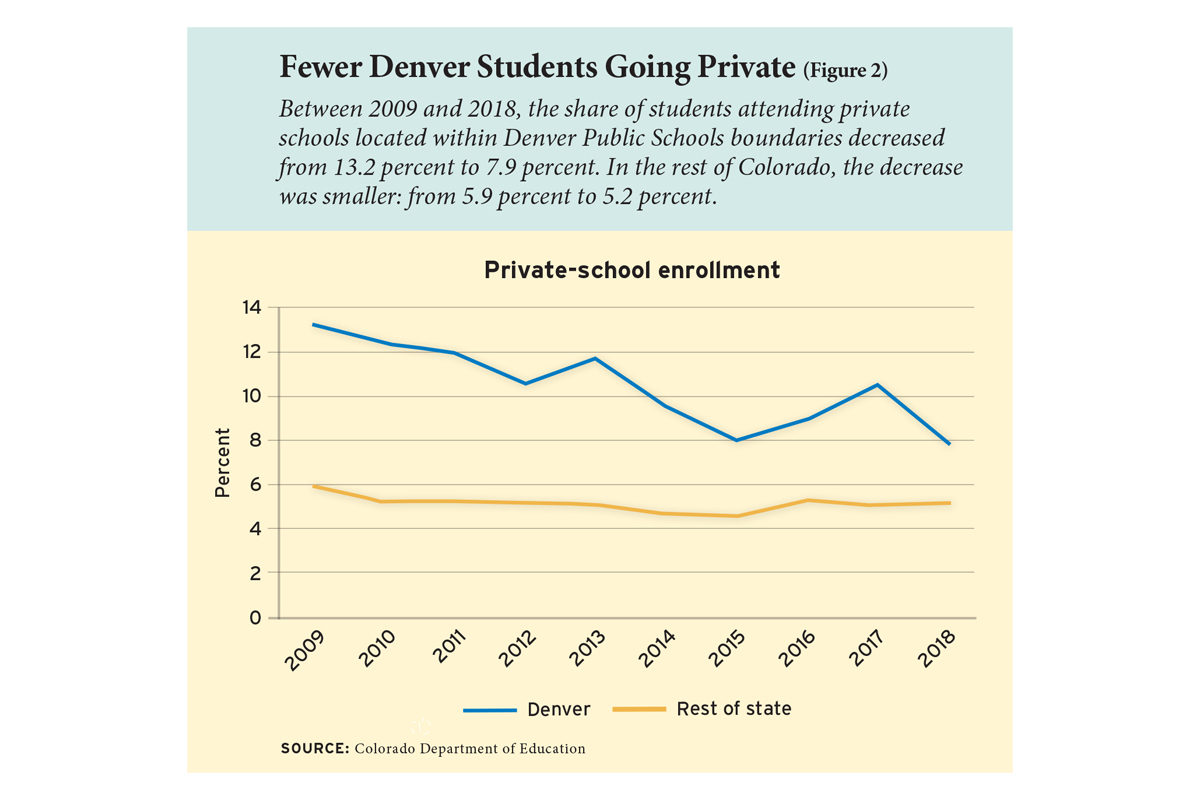
Measures of improvement in student performance must be evaluated in light of any changes to the district’s student composition over Boasberg’s tenure. Despite a remarkable DPS enrollment gain of more than 17,000 students, measures of racial, ethnic, and economic diversity are little changed. In 2018, as in 2009, a majority of DPS students were members of minority groups, though there has been a slight increase in white students (see Figure 3a). The share of Denver Public Schools students receiving free or reduced-price lunches has remained stable, while the share of English learners has increased slightly (see Figure 3b).
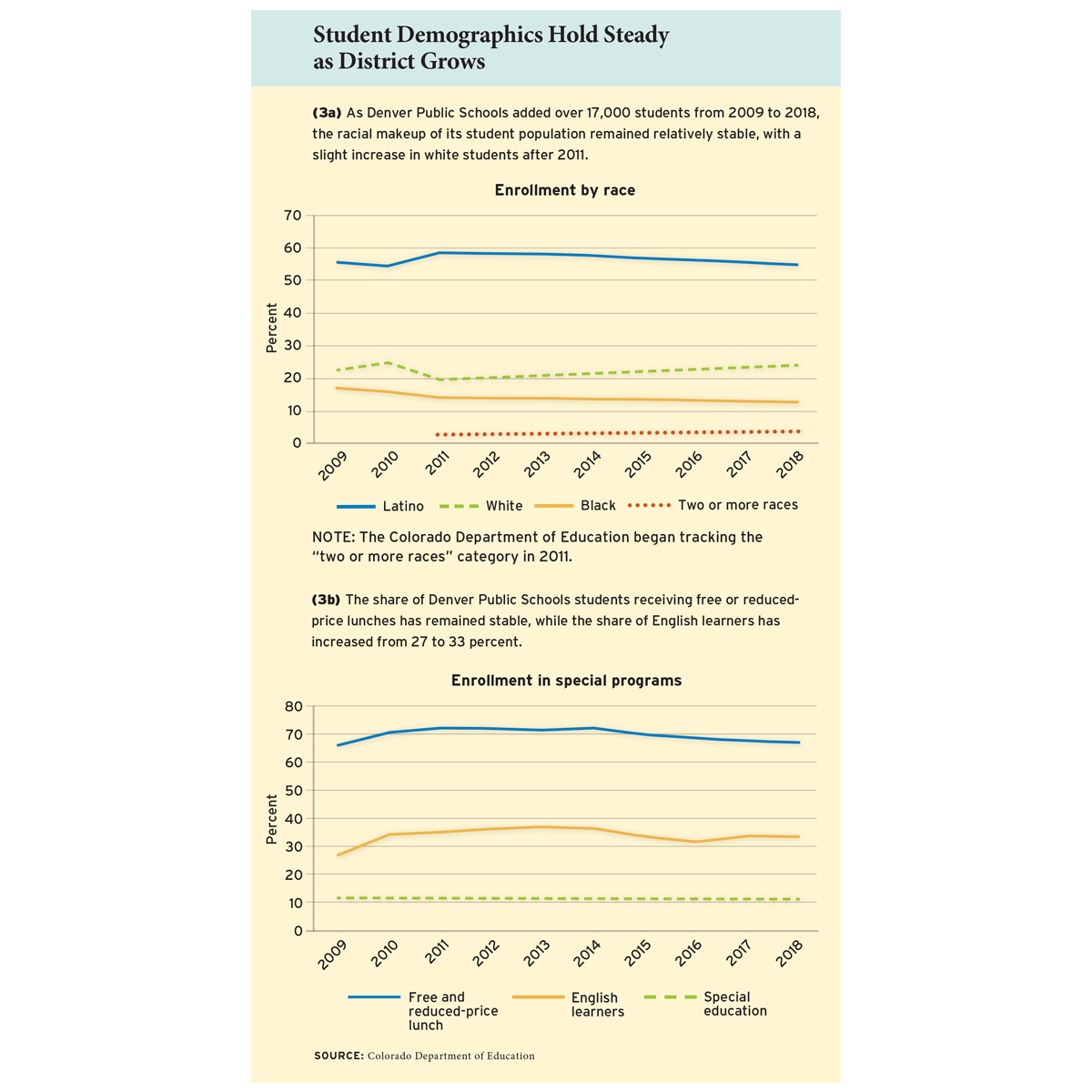
DPS experienced substantial improvement in the four-year graduation rate since the 2009–10 school year, when a new formula for graduation rates was adopted (see Figure 4). Latino students registered the greatest gains. The progress in graduation rates is mirrored by a declining drop-out rate. And finally, remediation rates—proxies for how prepared graduates are for higher education—also fell during Boasberg’s term, while the immediate college-going rate rose.
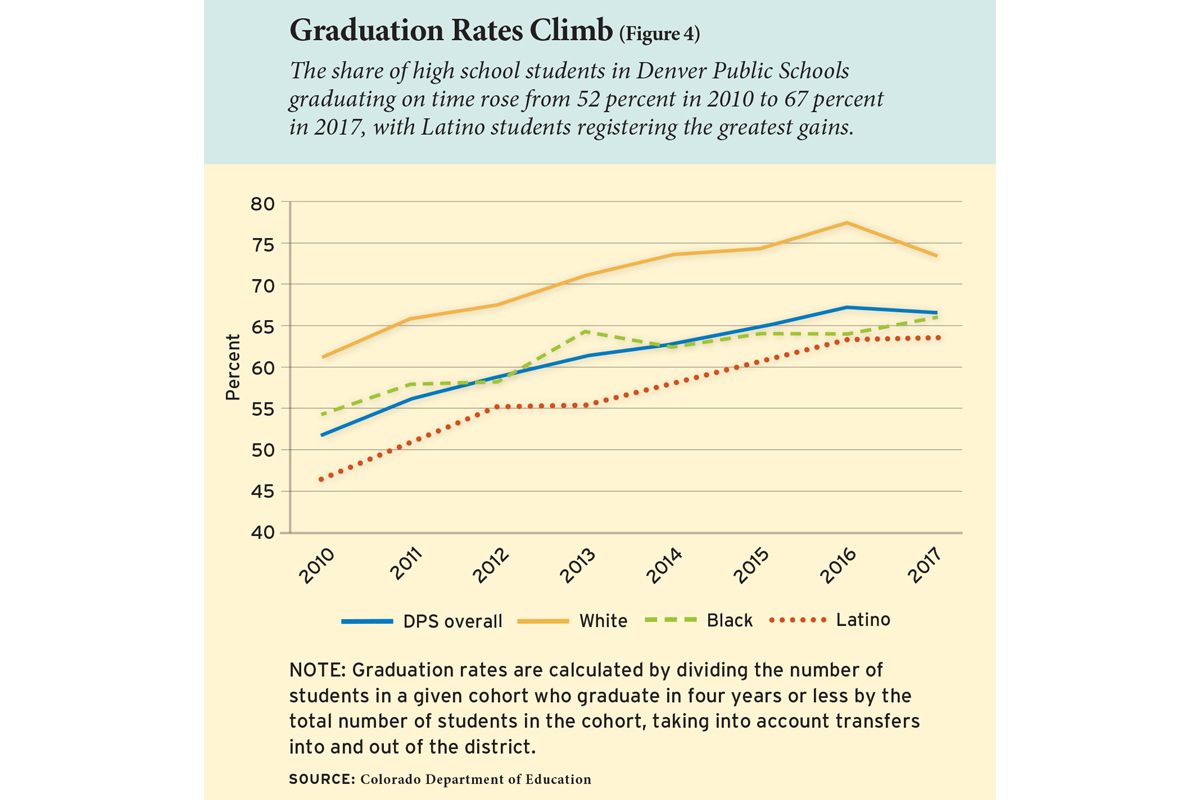
Improvements in the district’s academic performance were already taking place when Boasberg took the helm of DPS. Outside observers noted that between 2005 and 2010, DPS moved from worst in median student academic growth to join the top large districts in Colorado in achievement. Under Boasberg, the district has experienced faster-than-average growth in student achievement based on the state’s growth model but still lags state levels of proficiency, with worrisome gaps between student subgroups (see Figure 5).
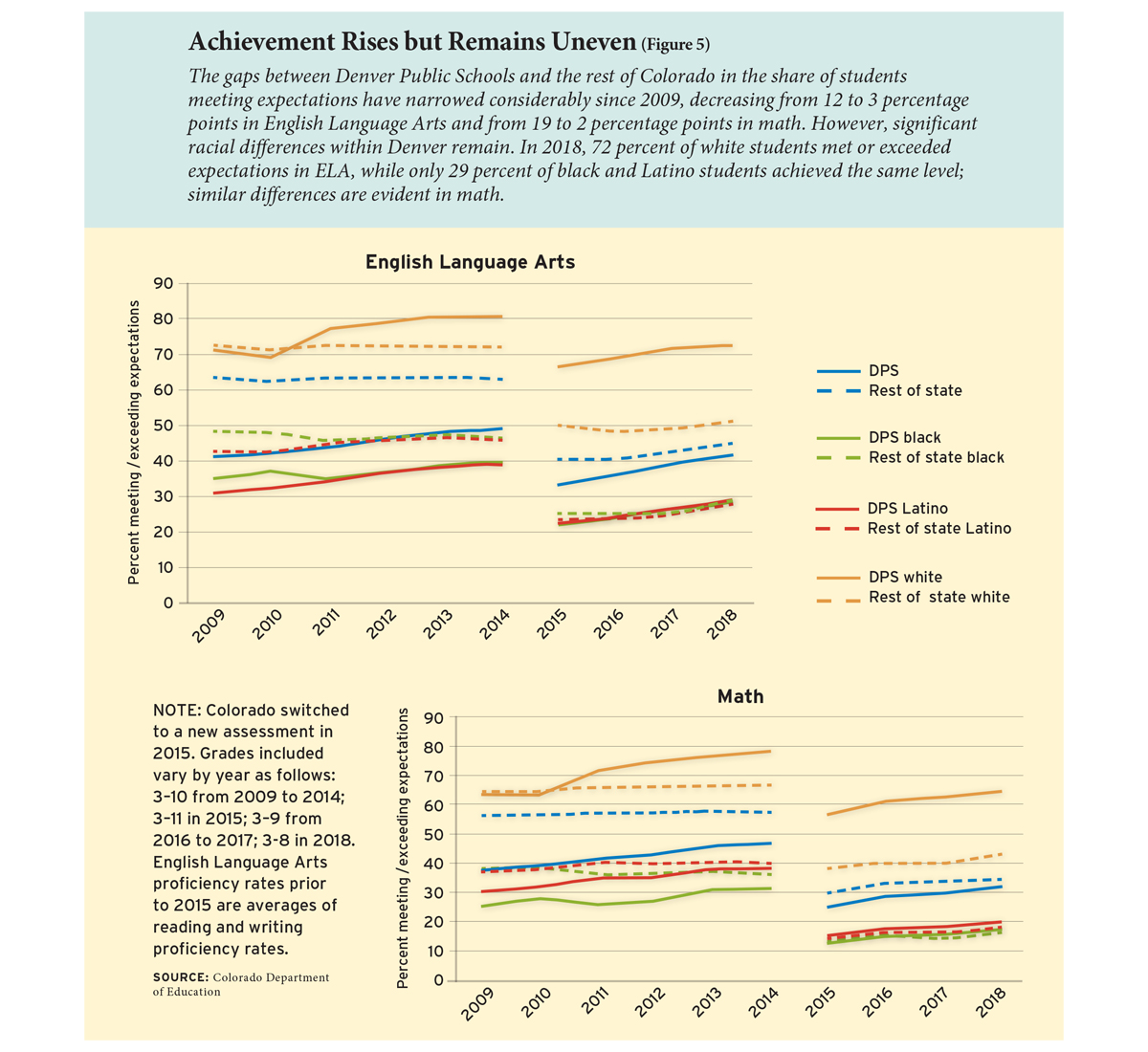
On the National Assessment of Educational Progress (NAEP), the organization A+ Colorado concluded that DPS students in 2017 performed roughly at the midpoint of large urban districts nationally, but with more dramatic achievement gaps along socioeconomic lines. Attributing changes in district performance to specific types of schools (traditional, innovation, or charter) is challenging. Education Research Strategies reports growth in ELA achievement for all types of DPS schools, but highlights an outsize contribution from charter schools. A+ Colorado found in May 2017 that the “schools with the largest gains in relative performance show that a variety of schools and educational programs have demonstrated improvement: from traditional district-run schools, to specialized programs, to charters and innovation schools.”
The Center Did Not Hold
Still today, some of Boasberg’s critics, committed to the monolithic system he sought to transform, are demanding that the district return to its old ways. The teachers union wants to jettison the district’s pay-for-performance system and revert to the traditional step-and-ladder salary scale. Some community groups want to abandon the common-enrollment system and go back to attendance boundaries. The union has called on the district to replace its multi-measure school performance framework with the state’s less rigorous version. And Boasberg’s most ardent adversaries don’t cherry-pick. They oppose all of the changes.
Why, though, do some who originally supported his approach also see his tenure as a failure (or at least nothing to celebrate)? The answer says a lot about Boasberg, but it says more about the state of bipartisan education reform.
When Boasberg became superintendent in 2009, a pro-reform Democrat was in the White House, Boasberg’s friend and predecessor was in the U.S. Senate, and Democrats for Education Reform was on the rise. His boldest reforms came in these early years, when his support among fellow reformers was strongest. He was able to implement radical changes by framing them in terms that were at once pragmatic and aspirational. Appealing to liberals’ sense of fairness, he confirmed their belief that the system was rigged against the least advantaged. By making transformation of the district a moral imperative—one necessary to right a historic and ongoing injustice—Boasberg managed a diverse coalition of support among civic and business leaders, community advocacy groups, and supporters of charter schools and choice. But the trajectory of his impact and influence in Denver tracks neatly with the fate of bipartisan education reform in Washington, D.C., and across the country. As the shared enthusiasm for standards, accountability, and choice began to fade, so too did Boasberg’s shine.
By his own admission, Boasberg is an introvert who lacks the charisma and political skills of his predecessor. Perhaps partly because of that, he may have been more willing to make decisions that could have ended his political career. This courage earned him a national reputation as a bold reformer and helped him secure the support of many advocates who had long attacked the district.
For a time, Boasberg seemed unstoppable. Ironically, he implemented many of his most aggressive reforms in his first four years in office while he had the support of only four of the board’s seven members. Boasberg eventually gained the support of the entire board when a slate of reform-friendly candidates replaced his three detractors in 2013. But by that time cracks had already begun to emerge in his coalition. With the board’s unanimous support, his advocates expected him to move their agenda along more aggressively. When he didn’t, he sealed his fate.
In the years that followed, even as Denver continued to rise in national prominence, many of Boasberg’s leading supporters grew frustrated as it became clear that he was content to let the district, as one onetime supporter complained, “coast on its past successes.”
In 2017, Boasberg lost the unanimous support of the board when two opponents of his reforms won seats. Also that year, he suffered a major setback when education and civil-rights advocates succeeded in pressuring the district to revise its controversial school-rating system after acknowledging the inclusion of measures advocates said masked low performance. In retrospect, that debacle may have caused the final crack in Boasberg’s fragile coalition. To opponents and supporters alike, it was proof that the district couldn’t be trusted.
In the end, even some of his strongest stalwarts turned against him. Theresa Peña, who served on the DPS board from 2003–11, and as chair for five years, had taken a lead role in the reforms. Yet in February 2018, she wrote a scathing column in the Denver Post declaring the district’s strategy a failure, arguing that no one—not “students, teachers, principals or community members”—was “better off as a result of the reforms put in place by the school board.” She asserted that “until and unless Boasberg and the Board of Education take concrete steps to fundamentally change the district to serve its students and schools, real progress will remain elusive.”
Two months later, Tony Lewis, CEO of the Denver-based Donnell-Kay Foundation and an early supporter of Boasberg, explicitly called for a change in leadership. Boasberg always had critics, but when their company grew to include some of his strongest supporters, his strategy of bold but calculated change became untenable. Boasberg and DPS board members maintain that his departure was a mutual decision. Whether he chose to leave or was in fact forced out, his departure was not likely the one he had imagined for himself.
Not everyone was happy to see Boasberg go. The advocacy group Chiefs for Change called him an “extraordinary leader who has dedicated his life to expanding opportunities for all of Denver’s children.” Michael Bennet praised Boasberg’s leadership in the Denver Post, urging residents to recognize the progress made under him and not to retreat from his reforms.
Boasberg, for his part, says he left the district “in a fundamentally different and better place.” He is not wrong, but after all the changes he spearheaded, Denver, like other urban districts, is still failing to provide quality educational opportunities to all its students, especially its most vulnerable and historically underserved. In our broken education debate, this is the great obstacle to progress: one side wants radical, transformational change and the other wants nearly none. In the space between them, incremental improvement may be the best we can hope for. It may be that Boasberg was wrong to settle on a middle way, or it may be that no middle path was ultimately sustainable.
Boasberg may be disappointed that his legacy is in doubt, but he was likely pleased when the board chose the candidate he himself had groomed to succeed him. In a normal world, deputy superintendent Susana Cordova, a Denver native, a Latina, a graduate of DPS, and a former district teacher and principal, would be an obvious choice for superintendent. But despite the endorsement of more than 100 district principals and administrators, Cordova was denounced by many of the same people who pushed for Boasberg’s ouster. The anti-Boasberg camp opposed Cordova because they viewed her as complicit in his efforts. Ironically, those who support that transformation but think Boasberg failed to lead it all the way oppose Cordova for the same reason.

“Getting There Is Hard”
Evaluating a superintendent’s tenure is complicated—and highly politicized. Whether you “like” a superintendent depends in part on what that leader does and whether those actions fit with your ideas—not just on whether positive changes ensue.
Superintendents are visible public officials who are expected to be responsible for the performance of their district. They play a prominent role in the public imagination and are courted and paid as if they matter. Yet the question of whether they actually do has been little studied.
Evaluating Tom Boasberg’s superintendency is particularly complex because he was not a traditional superintendent and the initiatives he pursued are not commonplace.
Nonetheless, even on the measures by which traditional superintendents are judged, Boasberg’s tenure was a success. He weathered four board elections and two bond approvals and attracted millions of dollars in philanthropy. He oversaw the closure of schools, the construction of new ones, and the renovation of old ones. And most significantly, there is clear evidence that educational outcomes for students—including the district’s most historically underserved students—improved under his leadership.
Few other cities in the United States have so thoroughly altered the way they govern and deliver public education. How effective were the reforms he wrought? The evidence is still limited, but the changes themselves—from student-based budgeting, to performance accountability, to shared campuses, to school choice, to innovation zones—will not easily be reversed.
The job of superintendent is notoriously difficult and has been since it was invented over a century ago. The role was created to lead the school districts of the industrial age, but it has not yet been reimagined to lead the districts of the future.
Tom Boasberg’s tenure provides a glimpse of that reimagined position. But just as he did not fully reinvent the Denver schools, he also did not fully reinvent his role. That will be up to those who follow.
As Boasberg said when he began his job: “We have a pretty clear idea of where we want to go—getting there is hard.”
Parker Baxter is scholar in residence at the University of Colorado Denver School of Public Affairs, where Todd Ely is associate professor and Paul Teske is dean and Distinguished Professor.
This article appeared in the Spring 2019 issue of Education Next. Suggested citation format:
Baxter, P, Ely, T., and Teske, P. (2019). Redesigning Denver’s Schools: The rise and fall of superintendent Tom Boasberg. Education Next, 19(2), 8-20.


